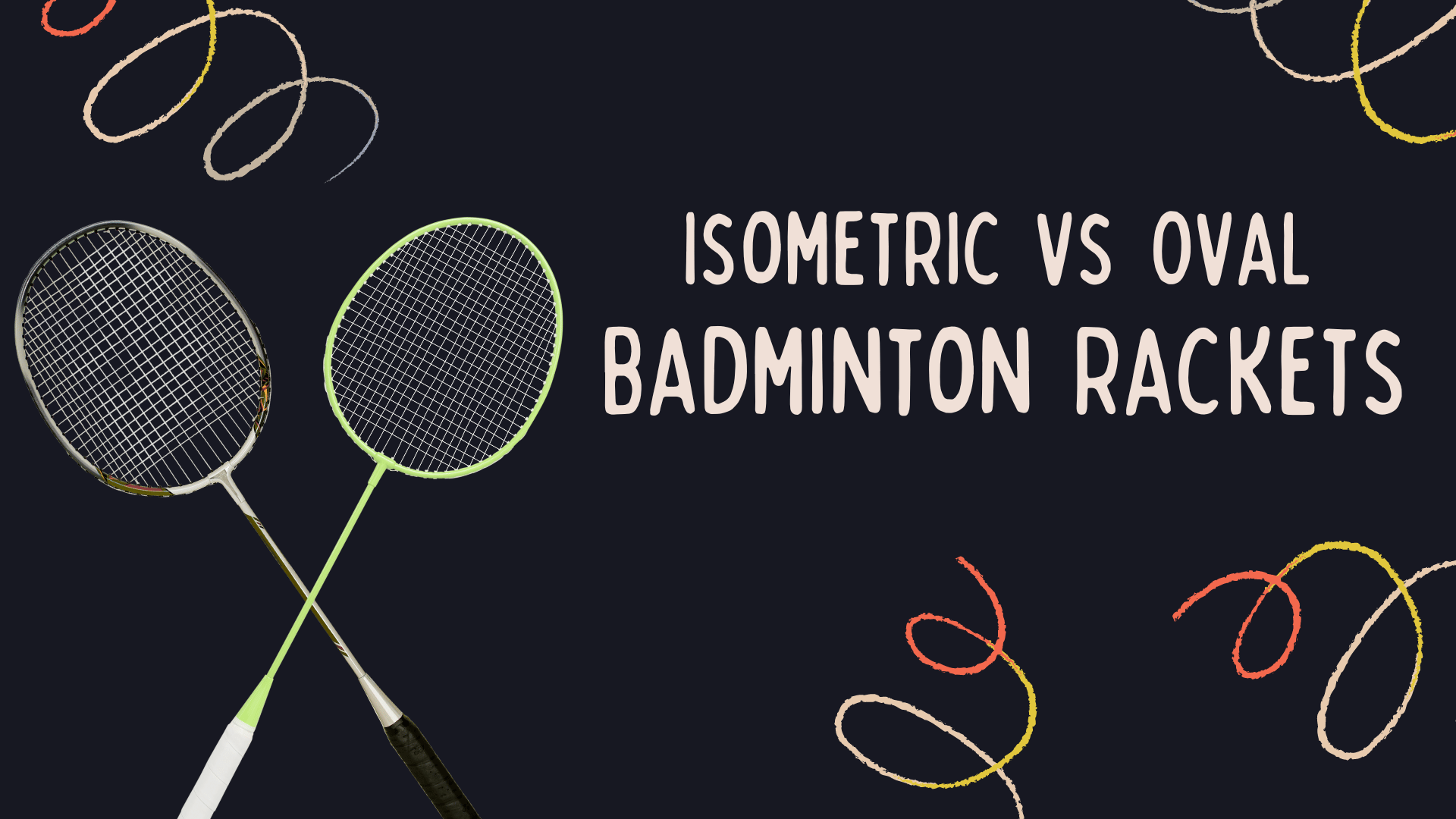You cannot play badminton without a racket. That does not mean you can grab just any racket and start playing. At the beginner level, that’s alright. You don’t have much command over the game. So, until you get the hang of the basics, you can use any random racket.
But as your skill level rises, you need a racket that suits your playing style. Commonly, badminton rackets come in two shapes.
- Isometric Badminton Rackets
- Oval Badminton Rackets
I am dedicating this article to learning about these two types of badminton rackets. You will see how they differ from one another and their functions so you can decide which type is most suitable for you.
Let’s begin by learning a bit about isometric badminton rackets.

Isometric Badminton Rackets
Isometric badminton rackets are somewhat squarish in shape. The squared-off top of the head creates a larger overall surface area than oval rackets.
It also has a larger sweet spot (The area of the racket that gives the best impact when the shuttlecock hits that area). This means players get a better chance of hitting the shuttlecock right.
Many players prefer an isometric racket because it is easier to play with. It gives you more power while hitting the shot and is less forgiving if the shuttlecock misses the center.
But if you are looking for precise shots, isometric rackets are not for you. Their precision is very poor because they are designed to focus more on power.
Pros of Isometric Rackets
- Forgiving on Off-Center Hits: Due to the larger sweet spot, off-center hits are less likely to go much astray than the desired position. Thus, a slight change of angle could be forgiving with the larger sweet spot.
- Powerful Shots: The design of isometric rackets helps generate more power. It is especially beneficial for players who prefer to play aggressive rallies.
Oval Badminton Rackets
Oval badminton rackets have an oval-shaped head. Compared to isometric rackets, they have a smaller sweet spot and a narrower head profile.
The smaller sweet spot on oval rackets demands a more precise technique to achieve maximum power and control. So, for beginners, an oval racket comes as a challenge.
However, experienced players who desire pinpoint accuracy and a more direct feel could benefit from an oval racket.
But if you are looking to play powerful shots, you will have to be very precise. The shuttlecock must touch the racket at the center of the sweet spot or you might not achieve the desired results.
Pros of Oval Rackets
- Greater Control: The smaller sweet spot allows players to take more precise shots. This is usually ideal for players who focus on accuracy.
- Feedback: Oval rackets tend to offer better feedback on hits. Players often praise the exact nature of shots achieved by these rackets.
Isometric vs Oval Rackets: Key Differences
Now, if you are still confused about how the two are different from each other, here’s a table highlighting the key differences between them.
| Features | Isometric Badminton Rackets | Oval Badminton Rackets |
| Shape of the Head | Square-ish shape head | Elongated, oval head |
| Size of the Sweet Spot | Larger sweet spot | Smaller sweet spot |
| Playing Style | Suitable for aggressive, power players | Suitable for control, precision players |
| Player Experience Level | Ideal for beginners and intermediates | Preferred by experienced players |
Choosing the Right Racket for You
There’s no one-size-fits-all approach in badminton rackets. You must use the one that feels most comfortable to you. For the scope of this article, we are focusing on one single feature – racket shape.
So, while choosing between isometric and oval badminton rackets, you need to consider the following factors.
Skill Level
Beginners must consider isometric rackets because of their larger sweet spot. A larger sweet spot gives you a broader area on the racket to hit the shuttlecock.
It’s okay if the shuttle doesn’t exactly hit the center. You will be able to achieve the desired result when the shuttle comes in contact with the racket anywhere on the sweet spot.
But oval rackets have a smaller sweet spot. You need to be very precise when you touch your racket to the shuttlecock. If you miss the spot, you won’t be able to achieve the desired shot. That’s why oval rackets are more suitable for experienced players.
Playing Style
All experienced players don’t use oval rackets by default. Some like to play aggressive offense, while others focus more on their defense strategy.
In defense, you must have more precision to block net shots and dives. So, an oval racket could serve you best.
But in an offensive gameplay, you need more power. That’s why an isometric racket is the better choice.
Personal Preferences
Some badminton players prefer powerful and aggressive shots. For them, isometric rackets are the best. Others need more control over their shots. They believe in precision instead of raw power. For them, oval rackets are perfect.
Conclusion
Now you know how isometric vs oval badminton rackets have different roles. Beginners will likely benefit from the power offered by isometric rackets. Advanced players, on the other hand, can benefit from the control and precision of oval rackets.
However, I highly recommend you try both types to see which feels most comfortable. Don’t hesitate to consult a badminton coach or experienced player for guidance.
FAQs
How do I choose a badminton racket for beginners?
Beginners must choose an even-balanced badminton racket with a grip according to their palm size. They will benefit more from isometric rackets due to their larger spot and more forgiving nature.
How do I know which badminton racket is better?
You can try different badminton rackets in the store and decide which feels more natural to you. Pick one that you could say is basically an extension of your arm.
